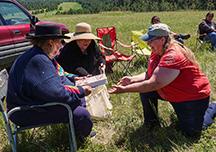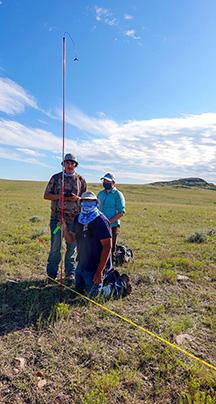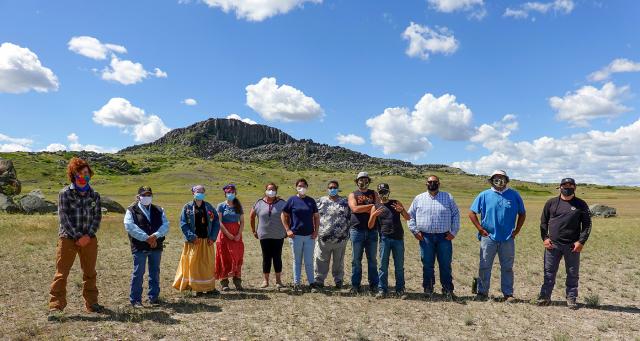You are viewing ARCHIVED content published online before January 20, 2025. Please note that this content is NOT UPDATED, and links may not work. Additionally, any previously issued diversity, equity, inclusion or gender-related guidance on this webpage should be considered rescinded. For current information, visit https://www.blm.gov/blog.
2020 Field Season AIMs for SOS Success: Fort Belknap Indian Community/BLM/Society for Ecological Restoration Native Seed and Grassland Restoration Program
Story and photos by: Wendy Velman, MT/DKs Botanist & Dr. Cristina Eisenberg, Program Director

Minerva Allen and MT/DKs
BLM Botanist Wendy Velman
sharing and exchanging plant
knowledge.
Photo by Dr. Cristina Eisenberg.
While the word restoration suggests degraded land incapable of recovery on its own, we found on this project that is not the case on the lands we worked. Our first season was focused on the BLM lands south of Hwy 191 and North of the CMR Wildlife Refuge in the Malta Field Office. I especially want to thank Tom Darrington, Field Manager, and his staff that helped line out the areas we could focus out first field season of work. Keeping the crews close to their home base on Fort Belknap Tribal lands help provide the fellows as much field time as possible while allowing for them to return home each night. We have a lot of great stories to share from this first season so I hope you will enjoy following the journey on this project. – Wendy Velman, MT/DKs Botany Program Lead
In fall 2019, the BLM entered a 5-year partnership the Fort Belknap Indian Community (FBIC) and the Society for Ecological Restoration (SER) to implement the Native Seed and Grassland Restoration Program.
The program focuses on the role of Traditional Ecological Knowledge (TEK) in ecological restoration, working in close partnership FBIC on BLM land and adjacent tribal land. Under the oversight of Wendy Velman, BLM Montana/Dakota State Office Botanist, and with guidance from Marcia Pablo, BLM Tribal Liaison, the program is being led by Program Director and Principal Investigator Dr. Cristina Eisenberg (Oregon State University), who is an Indigenous woman, and SER Executive Director Bethanie Walder. FBIC leads include the Tribal Council, Tribal Preservation Officer (THPO) Michael Black Wolf, FBIC Science Lead Dennis Longknife, Jr., Program Coordinator Daniel Werk, and tribal elder Donovan Archambault. We are happy to report that we have completed a successful first field season, despite the typical logistical and challenges created by the coronavirus.

First Nations member, Monroe
Fox (back right), working with
the fellows to measure
vegetation height, one of the
data sets collected on an AIM
plot. Photo by Dr. Cristina
Eisenberg.
Three full-time summer botany field technicians—Monroe Fox (a member of the Kainai First Nation), Kaden Ashdown, and Payton Feller—worked closely with Dr. Eisenberg (with Monroe’s engagement supported by the Blood Tribe Lands Department). As a 13-year-old, Monroe began doing botany work as a Community Conservation Fellow on Dr. Eisenberg’s grassland restoration project in southwest Alberta. Today she has worked as a technician for Dr. Eisenberg for three years and now plans to go to college and get a PhD in botany. She is an example of the strong benefits to Indigenous youth of Community Conservation Fellows programs. She joined our program as a Native young woman to be a role model for and mentor the FBIC Fellows.
On the Montana Northern Great Plains, in partnership with FBIC, we trained eight Community Conservation Fellows, selected by the Tribal Historic Preservation Office (THPO), in TEK, native plant identification, Assessment, Inventorying, and Monitoring (AIM) protocols, seed collection in compliance with the BLM Seeds of Success program (SOS), and ecological restoration based on SER Standards. Many elders supported the project, led ceremonies, and shared their TEK to improve the outcomes for the Fellows and program overall.
The Community Conservation Fellows did an outstanding job and learned the methods and protocols rapidly. They became highly adept at using the sophisticated data-management system created by BLM, which involves data entry on tablets using NRDC plant codes.
In our AIM plots on BLM land used for cattle grazing, we identified several highly productive native grass populations. The Fellows helped make several robust collections of seeds for plant restoration which were shipped to the Bend, Oregon, Seed Extractory.
We are also partnering with the THPO to collect and protect historical knowledge from within their community of elders. Program Coordinator Daniel Werk is interviewing elders to better understand the role of important native plants from both a cultural perspective and for use in restoration, working through the THPO.
In addition, we hired Donovan Archambault on contract to develop a TEK restoration guide for the tribes. The THPO/FBIC will determine which information will remain exclusively within FBIC and which information can be shared publicly.
We are thrilled to be working with FBIC and SER on this important and innovative project and look forward to planning for another successful field season next year, in keeping with FBIC COVID-19 safety protocols.
Besides assessing and restoring public lands, this long-term program’s objective is to support and restore wellbeing to a Native American community by providing education and job opportunities and by obtaining program resources such as housing and food directly from the FBIC. As an example, Dr. Eisenberg has selected five of the Community Conservation Fellows to work as field technicians on this program in 2021. Dr. Eisenberg will work with BLM and SER to obtain fellowships during the academic year to further support their development as restoration ecologists within a TEK framework. She has secured matching funds for the fellows to help prepare them for being afield.

Wendy Velman, MT/DKs Botanist & Dr. Cristina Eisenberg, Program Director
Related Stories
- 11-year-old Touren Pope discovers ancient turtle fossil on BLM land in Wyoming
- Popular posts: BLM's most viewed blogs of 2025
- Using science to uncover mysteries of the Mesa archaeological site in Alaska
- Agua Fria National Monument: A desert oasis with a rich history and a vital present
- Monument map earns ‘finalist’ honors in global GIS awards
